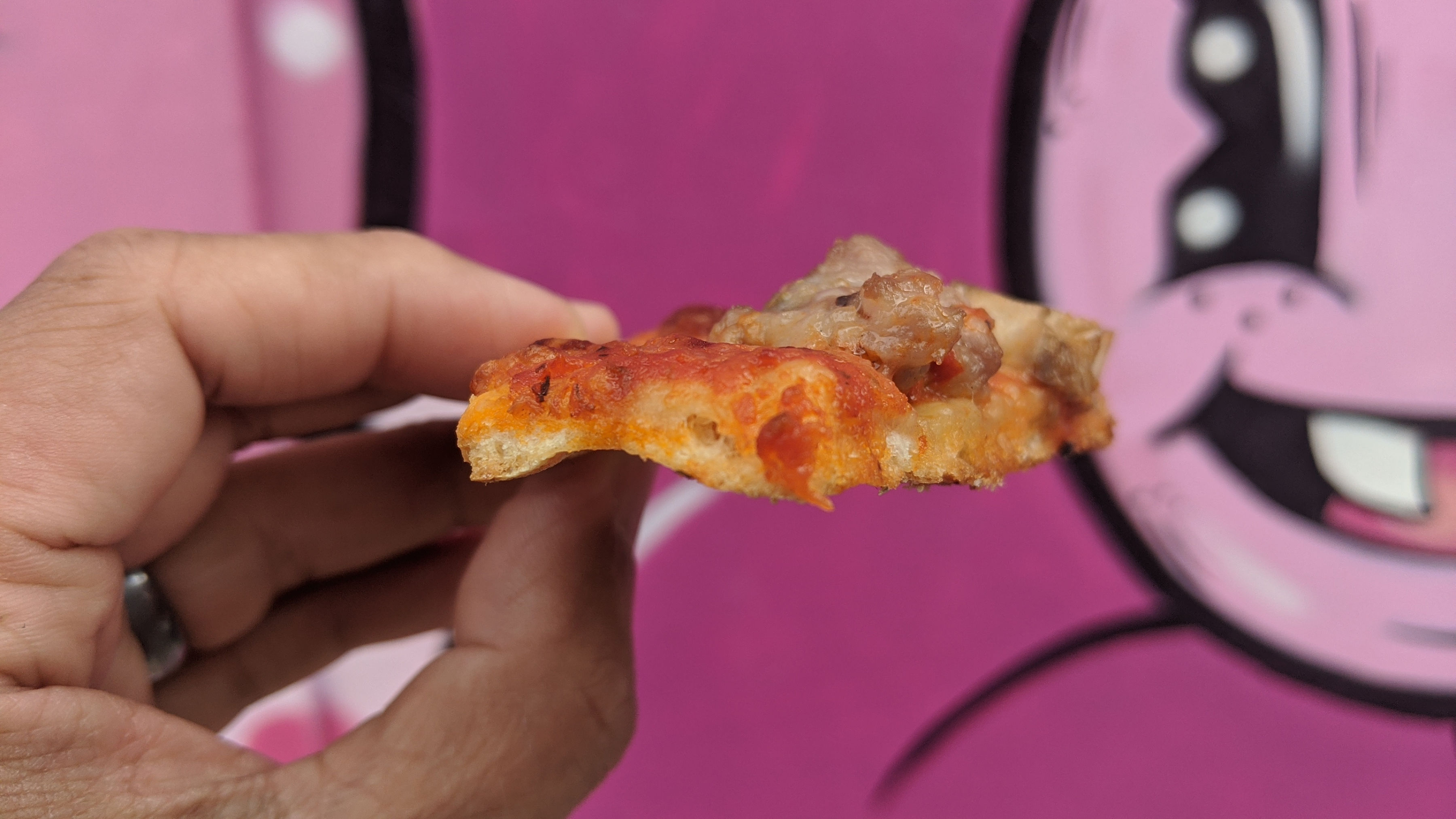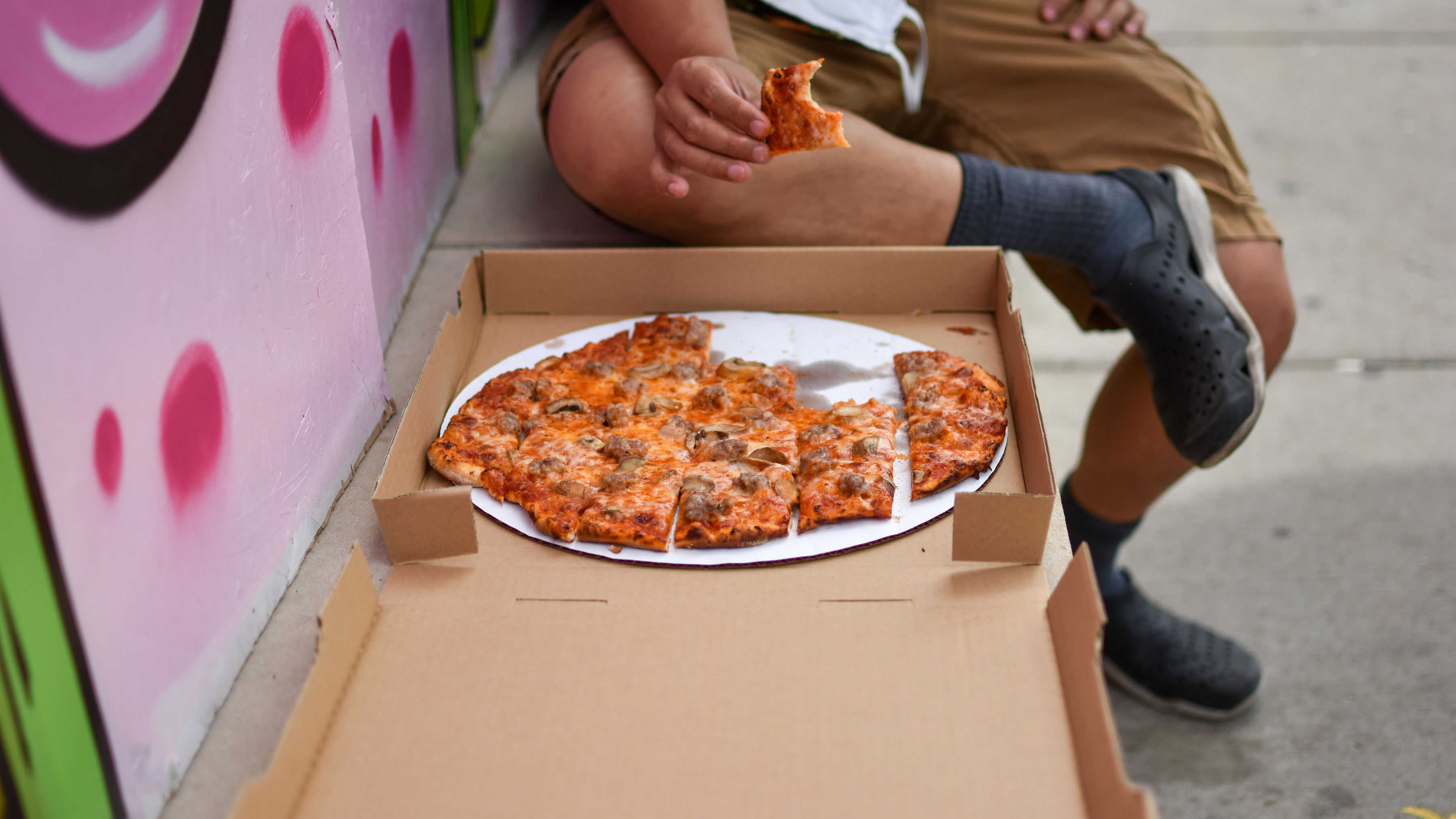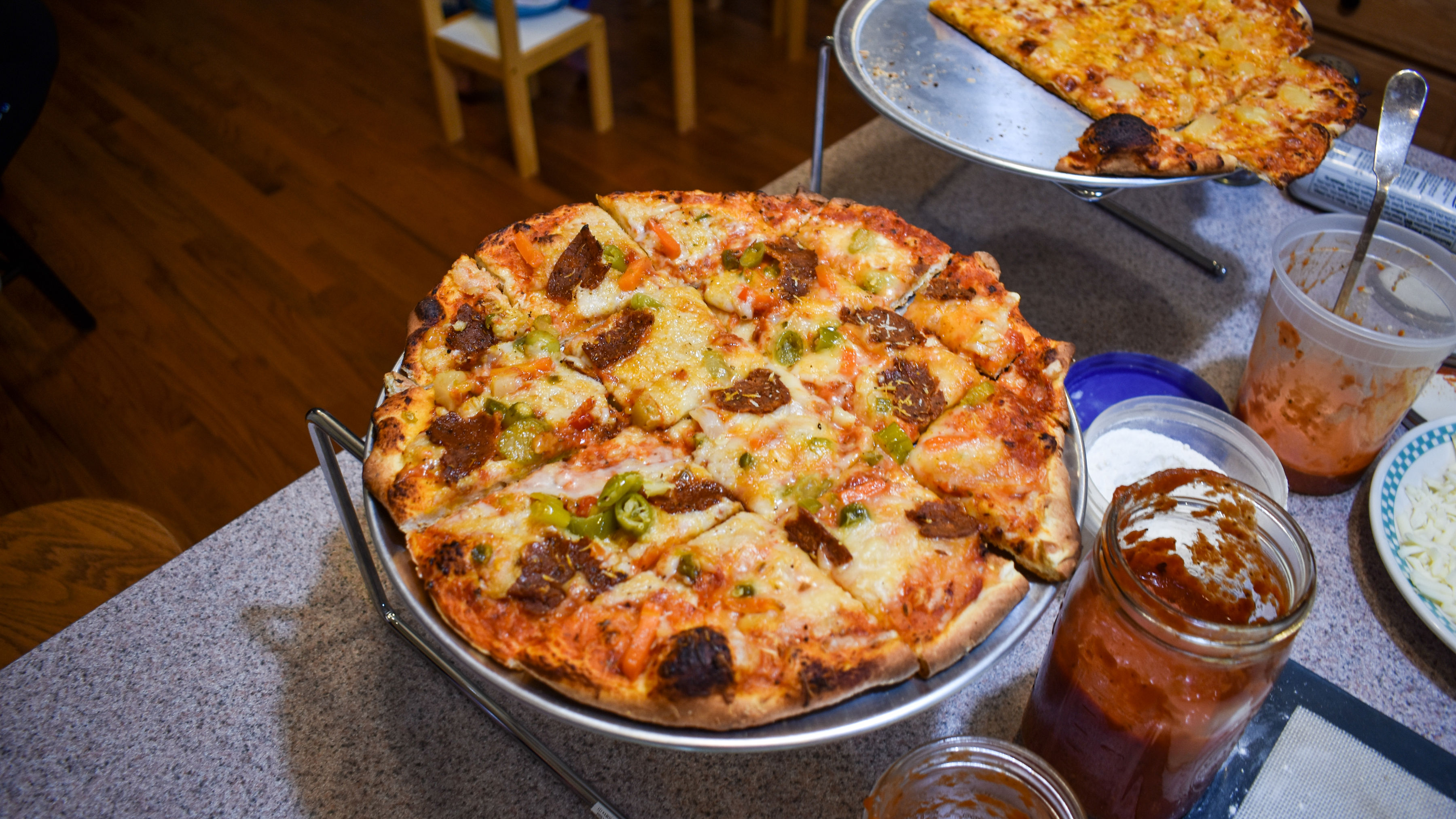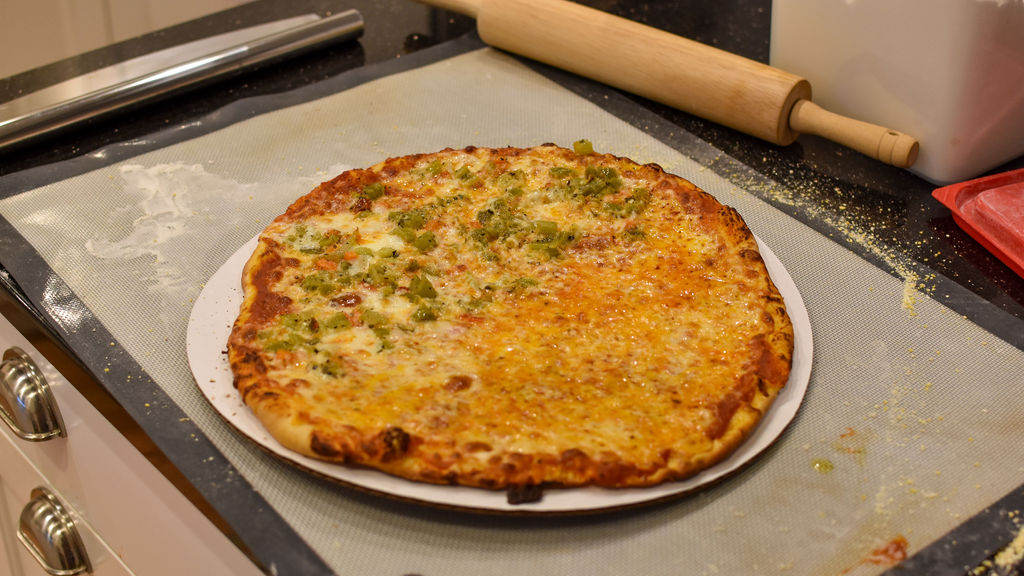The Pizzadad Chronicles, Or My Obsessive Quest To Make The Best Chicago Tavern-Style Pie At Home
You first feel like a father when you hold your tiny, precious child. But you first feel like a dad when you find yourself spending inordinate amounts of time dicking around with the incredibly minute details of a hobby you picked up out of nowhere.
For my own dad, it was first woodworking, then collecting and trading World War I–era Lee–Enfield rifles. For me, at present, it's an obsessive fixation on Chicago tavern-style pizza. I make a solid New York pie, I can manage a Detroit pan pizza, and I even have a fancy wood-burning oven for Neapolitan, but lately for me, it's been tavern style or die.
Every single Friday night, the family and I make a bunch of square-cut pizzas and find something to watch on Disney+. Then, from Saturday to Thursday, I ruminate over the next time I'm going to get to make pizza. I read pizza books, check out online used book stores, and scour the pizza forums that haven't had a UI update since I was in high school. It's all fantastic fun. Take a wander over to my Instagram—it's pizzas all the way down. I am Pizzadad now.
And what's an obsession without eagerly shoving it at everyone who shows even mild interest? Friends, I want you to make, and then love, this type of pizza as much as I do.
What is tavern-style pizza?
Tavern style is the square-cut thin crust pie that most Chicagoans grow up eating. It's crisp in bite, sweet and herbaceous in sauce, and balanced in toppings. I won't belabor the point that locals don't usually partake in the deep dish you all associate us with (and, frankly, Gwen Ihnat said it all), but it's at least worth mentioning here.
Chicago tavern-cut pizza originated in taverns, if you can believe it. Bar owners would set out pizza for drinkers cut into bite-sized squares in order to stretch the free food and eliminate the need for plates. Bar patrons could have a couple of squares on a napkin and still have room for their dinner. (This was, I should note, a period when a far greater proportion of men than today went to work, got loaded at bars, and then went home to the family.)
Some also call it "party cut" for its popularity at birthday parties. I knew my own recipe was dead-on when I could close my eyes, take a bite, and instantly be transported to Denise McCarthy's ninth birthday party at the 3-D Bowl in Island Lake, Illinois.
Bottom line: this is a regional pizza style that some people fall hard for, and I'm currently using it as a substitute for meaningful relationships with people outside of my blood family. And I have to say, that's all going pretty great.
What makes a good one?
Following months of at-home service to my wife and kids—never straying from the tavern-cut pizza that the family found perfect for pale ale, red wine, and Wall-E—I had a recipe I thought hit all the authentic notes. But anything can work at home. Those people are obligated to be nice to you.
To give a personal obsession some wider and more authoritative context, I sought out a pizza-maker with far more credibility to judge the result: Derrick Tung, owner of Paulie Gee's Logan Square. Derrick and his team have been acclaimed for both their Neapolitan and Detroit-style pizzas (and hoo boy, the acclaim undersells it if anything), but Derrick's carried the torch for tavern-style as long as he can remember.
"Growing up around here, it's the standard for birthdays. My early memories of it are all tied up with parties and Ms. Pac-Man," he said. "Today I've got a few favorites for when I'm wiped after a late night at the restaurant and feeling munchy. These days, I focus on the crunch from the crust, how much flavor is in the dough, the blend of cheese. But mostly just how much you want to keep eating it." As he talked, he worked his way steadily through the pie I'd brought to our meeting. He's either very polite or he tacitly approved.
Next, I took a pizza to Taco in a Bag, the delicious it-is-what-it-sounds-like restaurant owned by friend of The Takeout Pat Bertoletti. Most people know Pat for his eating feats (fEATS?) but he deserves far more credit for being a flavor genius with impeccable technique. He traded me a spectacular griddle-cooked burger seasoned with Flavacol for one of my pizzas. He, like Derrick, is a born-and-raised tavern crust devotee. And as a classically trained chef, he's got a whole checklist.
"Salt, grease, umami, balance with crust/cheese/sauce," he texted me afterward. "The sauce and cheese can't slide off when you take a bite.... I think a great tavern [pizza] is one where the taste is explosive and you will keep eating it as long as there is still some in front of you."
The last pie went to local emcee Rich Jones, who I picked as both a lifelong resident of tavern-crust country and as a guy who really appreciates the finer points of marijuana. If you want your pizza judged for pure charisma, you gotta turn to a weed guy.
"A good tavern pie is all about balance! No one ingredient overloads the others," he said. "Also the crust can't be too thick or otherwise it's just a weird doughy thing. Giardiniera gives the pizza a good pop, but it works well as a good old-fashioned cheese pizza too. Throw in a tasty Pilsner and it's a real treat."
The main thing I'm omitting here is the considerable amount of time we spent debating our favorite neighborhood places (Marie's forever!). I'll spare you that, but there's always the comment section.
Let’s make it!
Here, fresh from the rabbit hole, is the pizza recipe I've honed over the past few months.
If you don't want to fall into the Pizzadad vortex, replace the kyrol flour with regular bread flour (King Arthur has a good volume conversion tool), bake at whatever temperature your oven maxes out at, and use an oiled rimless baking sheet instead of the steel or stone. Buy jarred sauce and pre-shredded cheese if you want. The important part is to have some fun out there.
I've also made this for vegan family members with dairy-free cheese and meatless Italian sausage. They loved it. The crust and sauce didn't need much adaptation, and it's fun to include people. Cook for the vegans. Cook for the meat Pac-Men. Cook for everyone, because pizza is the best and practice makes perfect.
Pizza Sauce
- 2 Tbsp. butter
- 2 Tbsp. olive oil
- 4 cloves garlic, smashed and peeled
- 6 oz. tomato paste
- 1 tsp. dried marjoram
- 1 tsp. dried oregano
- 1 tsp. dried basil
- 1 (28-oz.) can whole tomatoes in juice (or San Marzano tomatoes, if you find a good sale)
- 2 Tbsp. fish sauce
- Malt vinegar, red wine vinegar, or sherry vinegar, to taste
Melt the butter and oil over medium-low heat in a medium saucepan, then add the smashed cloves of garlic. Fry for 4 minutes, until lightly browned.
Add the tomato paste and cook until it darkens, about 5 minutes.
Add the spices, cook one minute, then add the tomatoes and juices.
Stir in the fish sauce and bring to a simmer. Cook 20-25 minutes, stirring occasionally and crushing tomatoes against the side of the pan.
Remove from heat. Using an immersion blender, blend to desired consistency, and season with vinegar to taste. Let cool completely before spreading onto the pizza. You can make the sauce up to a week in advance.
Chicago Tavern Crust
- 725 g. high-gluten bread flour (kyrol flour)
- 25 g. medium-grind cornmeal
- 4 g. instant yeast
- 7 g. salt
- 7 g. sugar
- 370 g. warm water (90-100 degrees Fahrenheit)
- 60 g. olive oil
Add the dry ingredients to a food processor bowl fitted with a dough blade. Pulse until combined, then add the water and oil.
Pulse ingredients on the dough setting until the ball comes together and rides the blade. When that happens, turn the processor on fully, count to 40, and turn off. Let the dough rest 20 minutes, then process for another 30 seconds and remove to a cutting board.
Divide the dough into four equal pieces (about 295 grams each) and form into balls. Store each in a separate quart container or gallon zip-top bag. Refrigerate at least overnight or up to five days.
The Pizzadad Classic
- Chicago Tavern Crust dough
- Pizza Sauce
- 2 oz. ground Parmesan per pizza, plus extra for topping
- 6 oz. mozzarella per pizza, shredded
- Your favorite toppings (see note below)
Remove dough balls from the refrigerator at least three hours before you want to use them. For the best results, bring them to temperature covered and flattened on an aluminum surface.
Preheat a baking steel or baking stone in the oven for at least an hour before cooking. If your oven goes to 550 degrees Fahrenheit, turn it up to that. If not, take it as high as it goes.
On a clean, lightly floured surface (I usually just use my counter), press out a dough ball with your palm and begin pressing out with your fingers to form an eight-inch round.
Start stretching the dough with a heavy rolling pin (if it keeps pulling back, give the dough a few minutes to rest and try again). Roll out to a circle 14" in diameter. It might look a little uneven, but so do the pizzas from really good neighborhood places, so I wouldn't worry. It's going to taste awesome even if the first few times look a little ugly.
A Pizzadad pep talk: You're not going to be great at this right away, and that's kind of the secret to making good pizza. Stick with it, realize no one gives a shit what it looks like if it tastes good, and you'll improve a bunch along the way. Don't get frustrated.
Lay out the stretched dough on a cornmeal-lined pizza peel, and dock the dough using a docker or a fork. This the the key to good crispy crust.
Add four ounces of sauce with a ladle, spreading thin to the edges. Add two ounces of grated Parmesan. Add six ounces of mozzarella. Add your toppings, then another thin layer of Parmesan.
Knock the oven temperature down to 500 and slide the pizza onto the steel/stone. Bake. Check on it at 8 minutes, though it can take up to 10 to cook through. Turn it with a metal peel or spatula halfway through if it's cooking unevenly.
Remove, let cool 2-3 minutes, then slice into squares.
A note on toppings
Pepperoni is king most everywhere, but Chicago is by nature a sausage town. Fresh, hot, fennel-packed Italian sausage is the default topping here, though no one hates on pepperoni.
We also have what we call "Garbage Pizza," which, give or take some olives or other fridge leftovers, is a supremely satisfying combination of sausage, green peppers, mushrooms (preferably fresh, though opinions vary), and onions.
Aside from that, I would highly recommend drained giardiniera (either hot or mild). Years ago, I played 16-inch softball (no gloves) for possibly the worst bar team in the history of the game. We won our first game in our third year of existence and then were contracted out of that existence by the bar owners when they realized exactly how much we sucked. What kept us going that entire time? Cans of High Life sipped on the sly and tavern-cut giardiniera pizza from one of our other, less judgmental sponsors.



